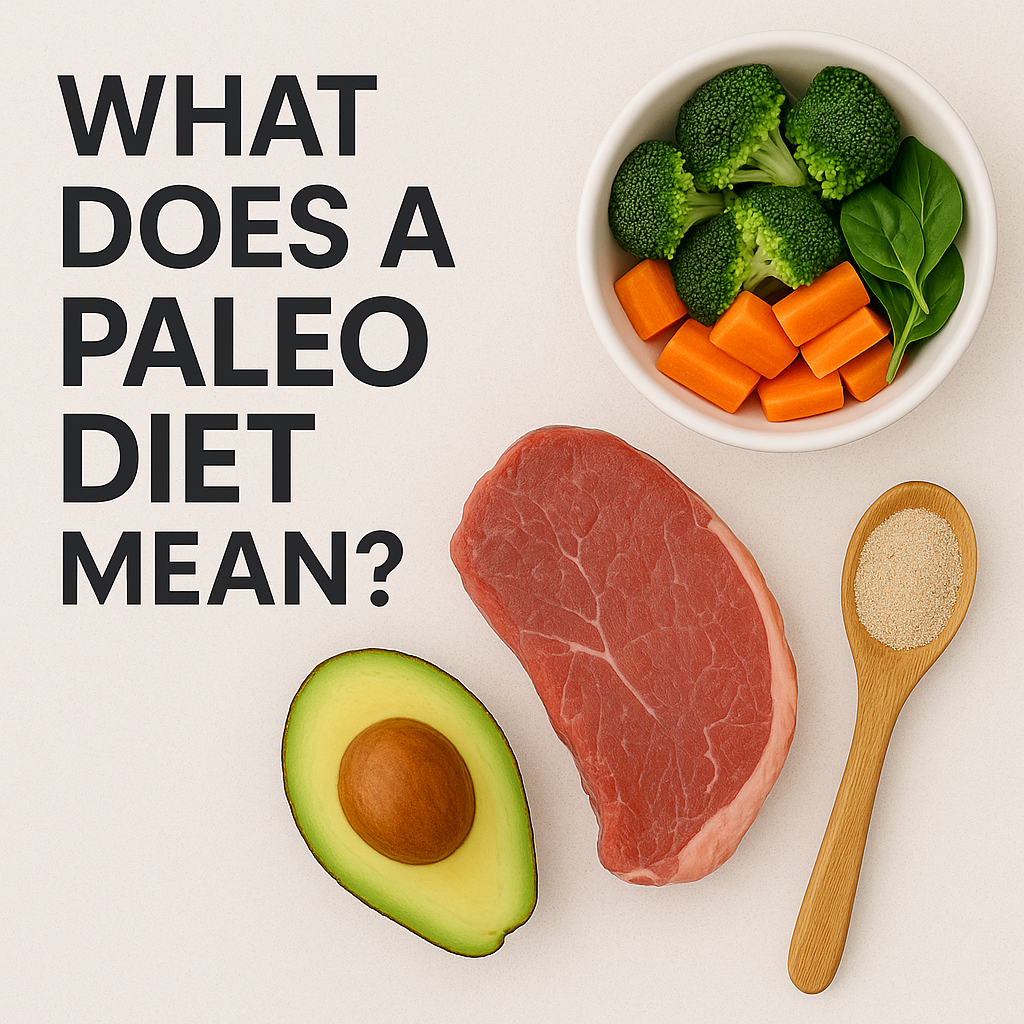What Does A Paleo Diet Mean?

What Does a Paleo Diet Mean? A Simple Guide to Eating Like Our Ancestors
Uncover the essentials of a Paleo lifestyle—what you eat, why it works, and how to adapt it to modern life.
🥩 What Is the Paleo Diet?
The Paleo diet—also known as the “caveman” or “ancestral” diet—is all about eating the way humans evolved to eat. This means focusing on whole, unprocessed foods like:
- Grass-fed meats
- Wild-caught seafood
- Pasture-raised eggs
- Vegetables, fruits, nuts, and seeds
- Natural fats and oils like avocado oil and grass-fed ghee
It eliminates inflammatory or processed foods introduced during the agricultural and industrial eras—grains, legumes, refined sugar, dairy (for strict Paleo), and seed oils.
For more science-backed details, check out The Science Behind the Paleo Diet.
🌿 Why Paleo? Key Benefits of This Lifestyle
Following a Paleo lifestyle can lead to:
- Stable energy without sugar crashes
- Better digestion and reduced bloating
- Healthier skin and joints, especially when paired with collagen peptides
- Fat loss and lean muscle retention, thanks to clean protein and whole foods
- Fewer cravings due to more nutrient-dense, satisfying meals
See why many believe Paleo is the best diet for long-term health and wellness.
✅ Paleo-Approved Foods to Enjoy
| Category | Examples |
|---|---|
| Protein | Grass-fed beef, wild-caught salmon, Vital Farms pasture-raised eggs, CHOMPS beef sticks |
| Veggies | Broccoli, spinach, cauliflower, sweet potatoes |
| Fruit | Berries, apples, citrus |
| Healthy Fats | Chosen Foods Avocado Oil, 4th & Heart Ghee, Nutiva Coconut Oil |
| Nuts & Seeds | Kirkland Raw Almonds, Viva Naturals Chia Seeds |
| Flour Alternatives | 365 Almond Flour, Bob’s Red Mill Coconut Flour |
🚫 Foods to Avoid on Paleo
- Grains (wheat, oats, corn, rice)
- Legumes (beans, lentils, soy, peanuts)
- Dairy (except ghee or grass-fed butter, optionally)
- Refined sugars and seed oils (canola, soybean)
- Packaged/processed foods
Want to avoid the most common missteps? Read Top Paleo Diet Mistakes so you can stay on track.
🧃 Helpful Paleo Staples & Kitchen Tools
💡 Pro Tip: Make your Paleo life easier and tastier with a few essentials:
- Protein Powders: Ancient Nutrition Bone Broth Protein or Equip Prime Protein
- Snacks: RXBARs, EPIC Chicken Sriracha Bars, Bare Apple Chips
- Smoothie Boosts: Amazing Grass Greens Superfood
- Dairy Alternatives: Califia Farms Unsweetened Almond Milk
- Kitchen Gear: Instant Pot Duo 7-in-1, Dash Mini Waffle Maker, Prep Naturals Glass Containers
These tools make batch cooking and quick meals a breeze—especially if you’re following a 30-Day Paleo Meal Plan or prepping lunches for the week.
📘 Paleo Cookbooks to Get You Started
Cooking at home is essential. Try beginner-friendly favorites like:
- The Paleo Diet Cookbook by Loren Cordain
- Paleo for Beginners by John Chatham
- Against All Grain by Danielle Walker
🏁 How to Get Started Today
- Clean out your pantry – ditch processed foods and seed oils
- Stock up on Paleo staples
- Prep easy meals using tools like an Instant Pot
- Simplify snacks with items like Artisana Almond Butter or EPIC Bars
- Choose a guide like the Beginner’s Paleo Diet Guide to walk you through day one
🧠 Final Thoughts
The Paleo diet means getting back to basics—eating real food, ditching modern junk, and fueling your body the way nature intended. Whether you’re looking to improve digestion, boost energy, or support longevity, Paleo provides a sustainable, satisfying framework.
You don’t need perfection—you just need intention and a few Paleo-approved swaps to start feeling better fast.
